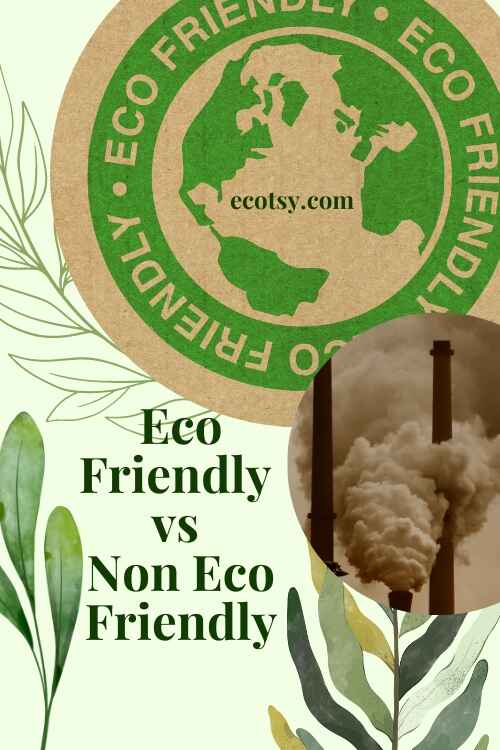
It is no secret that our planet is in trouble. The state of the environment is something that concerns many people, and for good reason. Between climate change, dwindling resources, and pollution, it can seem like the world is falling apart. Thankfully, there are things we can all do to help turn things around. One of those things is being more conscious about the products we buy. When it comes to choosing between eco friendly and non eco friendly products, what exactly does that mean? And which option is better for the planet? In this post, we’ll explore the difference between eco friendly and non eco friendly products, as well as the pros and cons of each. Let’s get started!
What is eco friendly and what is non eco friendly?
Eco-friendly materials and practices are those that do not harm the environment. These may include items made from recycled materials, renewable energy sources, or low-impact production processes. By contrast, non-eco friendly materials and practices are those that have a negative environmental impact, such as plastics derived from fossil fuels or chemical processes producing hazardous waste. Some examples of eco-friendly materials include bamboo and other sustainable woods, natural fibers like cotton or wool, and biodegradable paper products. Examples of non-eco friendly materials include PVC plastic, synthetic fabrics made with toxic dyes and chemicals, disposable plastics like water bottles and Styrofoam containers, and harsh detergents containing phosphate toxins.
The most environmentally conscious way to make purchases is to look for products made with eco friendly materials and processes. Whenever possible, shop locally produced items and support companies that follow sustainable practices. By taking the time to educate ourselves on eco-friendly alternatives, we can help reduce our impact on the environment.
Key differences between eco friendly and non eco friendly
- Eco friendly products are created using sustainable resources , while non eco friendly products use materials that are damaging to the environment.
- Eco friendly products are often made from organic or recycled materials, while non eco friendly items may be made from synthetic components or derived from unsustainable sources.
- Eco friendly products typically have lower environmental impacts due to their reduced energy consumption and fewer pollutants during production and use, compared to non eco friendly alternatives.
- Eco friendly products often have a longer lifespan than their non eco-friendly counterparts as they tend to be more durable and less prone to damage due to their natural construction methods.
- Eco-friendly products are often better for your health as they don’t contain harsh chemicals or toxins that could cause harm when used. Non eco-friendly products may contain these harmful ingredients, making them potentially dangerous to use.
- Lastly, eco friendly products tend to be more expensive than their non eco friendly counterparts due to the cost of sourcing earth-friendly materials and manufacturing practices. Thankfully, the increased price tag is often offset by the fact that eco friendly items last longer and are better for the environment.
The choice between eco friendly and non eco-friendly products can seem like a daunting one, but with a few simple steps you can make sure that your purchase has minimal environmental impacts. Doing research on available options in advance will help you determine which product is right for your lifestyle and budget while still being considerate of the world around us.

Pros of eco friendly over non eco friendly
- Eco friendly products reduce environmental impact. They are made from renewable, natural materials that are less likely to cause harm to the environment.
- Eco-friendly products are often more affordable than non-eco-friendly alternatives, making them much easier on the wallet.
- Eco-friendly products leave a smaller carbon footprint because they’re made with sustainable practices that don’t require excessive energy or water usage, and use fewer chemicals during production.
- Using eco-friendly products can help increase awareness of green living and encourage others to make more environmentally conscious decisions in their day-to-day life.
- Many eco-friendly products come with extended warranties and guarantees, giving you peace of mind that they will last longer than their non-eco friendly counterparts.
- Eco-friendly products often look better and more stylish than their non-eco friendly counterparts, making them more aesthetically pleasing to display in your home or office.
- Finally, eco-friendly products are generally less harmful to human health because they contain fewer toxic chemicals and pollutants than non-eco-friendly alternatives.
All of these benefits make choosing eco-friendly products a great choice for the environment!
Cons of eco friendly compared to non eco friendly
- Eco friendly products tend to be more expensive than their non eco-friendly counterparts.
- Eco friendly products may require more effort or research to find and purchase.
- Some eco-friendly products may not be as durable as non eco-friendly ones and thus need to be replaced more often.
- Some eco-friendly materials can be difficult to work with, so they may take longer and require additional skill when constructing something out of them.
- Eco friendly practices can require a lot of energy, water, or other resources in order to produce the desired result, which can have an environmental impact in itself if these resources are not managed properly.
- It is possible that eco-friendly practices could inadvertently cause harm to certain species or habitats ifnot properly monitored.
- Some eco-friendly products may not be available in all areas, making it more difficult to purchase them.
- Eco friendly practices may require additional legislation or regulations in order to ensure that they are effective and sustainable over time.
- Eco friendly practices can sometimes be perceived as inconvenient or inconveniently expensive by some people, which could make them less popular than other options.
- Eco friendly products and practices may not always provide the same level of performance or quality as their non-eco-friendly counterparts, which could cause disappointment for consumers who expect otherwise.
Pros non eco friendly over eco friendly
- Non eco friendly products are generally cheaper than eco friendly ones.
- Non eco friendly products require less effort to manufacture and are more readily available in the market.
- Non eco-friendly products may be easier to dispose of, as they don’t need any special treatment or processes for disposal.
- Non eco-friendly products have a longer shelf life (in terms of years) compared to their eco-friendly counterparts, as they are not affected by natural elements like sunlight or water etc., that can break down organic materials over time.
- Non Eco-Friendly products often come with warranties which offer peace of mind against damage or defect during the warranty period, whereas this is not always the case with Eco-Friendly alternatives.

Cons of non eco friendly compared to eco friendly
- Non-eco friendly products often require more energy and resources to produce, resulting in higher carbon emissions. This can contribute significantly to global warming and climate change.
- Non-eco friendly products typically use materials that are not biodegradable or recyclable, meaning they take up space in landfills for extended periods of time before decomposing.
- Non-eco friendly products may contain toxins or other hazardous chemicals that can be released into the environment and pollute air, water, and soil sources.
- The production of non-eco friendly products often results in water pollution due to runoff from factories and industrial sites where these items are made.
- Non-eco friendly products usually cost more than eco friendly alternatives due to their relianceon unsustainable materials and processes. This can be a burden on consumers who are looking to save money.
- Non-eco friendly products often require excessive packaging, which increases waste and adds to global pollution levels.
- The use of non-eco friendly products contributes to the depletion of natural resources, which could ultimately lead to an environmental crisis if not addressed in a timely manner.
- Non-eco friendly products typically have a shorter lifespan than eco friendly options, meaning they must be replaced more often and cause greater strain on the environment.
These cons make it clear why making the switch from non-eco friendly products to eco friendly ones is such an important step for businesses and consumers alike in helping protect our planet and ensure its sustainability for the green future.
Situations when eco friendly is better than non eco friendly
- Eco friendly products are more cost effective in the long run. Eco friendly products often have a lower initial investment, but the savings from reduced energy and water costs can add up over time.
- Eco friendly products are safer for you and your family’s health. Many non eco-friendly items are made with harsh chemicals that can be absorbed through the skin or inhaled into the lungs, leading to potential health risks.
- Eco friendly products contribute to a healthier environment. Non eco-friendly items like plastic bags, disposable diapers, and paper towels all end up as trash in landfills or as pollutants in our waterways — not good for our planet!
- Eco friendly products often last longer than non eco-friendly alternatives. Because manyeco-friendly items are made with renewable materials, they tend to be more durable and require less repairs or replacements over time.
- Eco friendly products support sustainable practices. By buying eco-friendly products, you can help reduce your carbon footprint and contribute to a greener planet for future generations. In addition, many of these items are produced using ethical labor and environmental practices — something that’s often lacking in non eco-friendly production processes.
Overall, choosing eco friendly products is an easy way to make a positive impact on the environment without sacrificing quality or performance. Plus, it just makes sense financially! So next time you need something new for you home or office, look for the green label first! You won’t regret it!
Situations when non eco friendly is better than eco friendly
- When the cost of eco friendly materials is high and it’s not worth the additional cost.
- When using non eco-friendly items or processes results in increased efficiency and less time spent on completing a task.
- When there are no viable eco-friendly alternatives available for a particular product or process.
- When you prefer convenience over sustainability, such as single-use disposable plastic products.
- When your business needs to produce large amounts of products quickly and existing technology limits the use of sustainable sources or technologies.
- When certain industries rely heavily on traditional methods, such as mining and oil production, where environmental impact is difficult to mitigate regardless of material choice or production methods used.
- In cases where lack of awareness about eco-friendly practices and products may prevent people from choosing to use them.
- When certain tasks require non-eco friendly materials, such as medical treatments or precision engineering that relies on non-sustainable sources of energy or materials.
- In situations where transitioning to eco-friendly practices would result in a significant disruption in existing infrastructure, processes and jobs.
- When the environment can recover quickly from the impacts of non-sustainable production methods, such as short term logging or construction projects.
Ultimately, it’s important for businesses to assess their individual situation and weigh up the pros and cons before choosing between eco-friendly alternatives and traditional methods. Understanding your current needs and budget is key in order to make an informed decision about which route is right for you.

Eco Friendly vs Non Eco Friendly Products Summary
We hope this article has helped you to understand the key differences between eco friendly vs non eco friendly products and given you a better insight into when each might be the better choice. If you have any questions, please leave them in the comments below – we would be happy to answer them!



